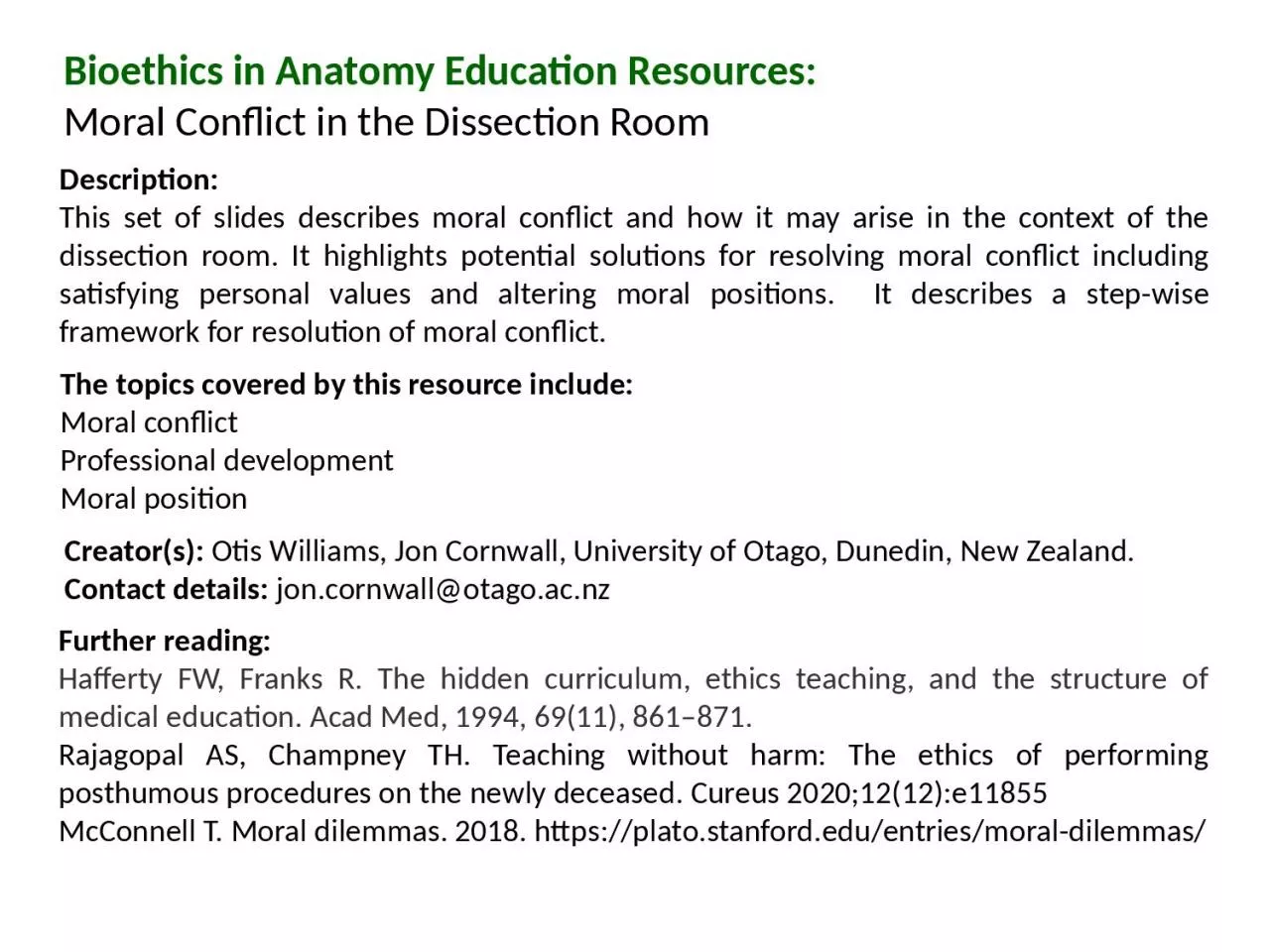

The topics covered by this resource include Moral conflict Professional development Moral position Further reading Hafferty FW Franks R The hidden c urriculum ethics teaching and the structure of ID: 1045407
Download Presentation The PPT/PDF document "Description: This set of slides describe..." is the property of its rightful owner. Permission is granted to download and print the materials on this web site for personal, non-commercial use only, and to display it on your personal computer provided you do not modify the materials and that you retain all copyright notices contained in the materials. By downloading content from our website, you accept the terms of this agreement.
1. Description:This set of slides describes moral conflict and how it may arise in the context of the dissection room. It highlights potential solutions for resolving moral conflict including satisfying personal values and altering moral positions. It describes a step-wise framework for resolution of moral conflict.The topics covered by this resource include:Moral conflictProfessional developmentMoral positionFurther reading:Hafferty FW, Franks R. The hidden curriculum, ethics teaching, and the structure of medical education. Acad Med, 1994, 69(11), 861–871.Rajagopal AS, Champney TH. Teaching without harm: The ethics of performing posthumous procedures on the newly deceased. Cureus 2020;12(12):e11855McConnell T. Moral dilemmas. 2018. https://plato.stanford.edu/entries/moral-dilemmas/Bioethics in Anatomy Education Resources:Moral Conflict in the Dissection RoomCreator(s): Otis Williams, Jon Cornwall, University of Otago, Dunedin, New Zealand. Contact details: jon.cornwall@otago.ac.nz
2. Moral Conflict and Professional DevelopmentResolving moral conflict is an important professional skill for healthcare workers to develop, because they may have to undertake healthcare delivery in situations, or with individuals, which do not align with their personal values. An example of moral conflict is observing continued life support which, in the eyes of the observer, may not be in the best interests of the patient.Not resolving moral conflict or not understanding how to do this effectively may lead to individuals becoming desensitized to questionable ethical practices or lead to despair or burn out.https://fineartamerica.com/featured/patient-on-life-support-bill-sanderson.htmlEach of us have our own moral positions, or collections of values, which guide our conduct. These values inform what we consider as acceptable actions in different situations. A moral conflict is when two or more of these values conflict; they cannot both be met at the same time. Moral conflicts produce cognitive dissonance and discomfort, which leads people to seek some form of resolution.
3. Moral Conflict and the Dissection RoomThe dissection room is a challenging environment. Working with body donors can be uncomfortable, especially if it challenges ones religious, cultural, social or spiritual beliefs. If a person is expected to undertake actions in the dissection room that are in opposition to their morals, they will experience moral conflict.https://en.wikipedia.org/wiki/The_Anatomy_Lesson_of_Dr._Nicolaes_TulpExamples of this might be as simple as believing that dissecting a body is a form of desecration, or being in the same room as someone who has died. It could also be more complex. For example, a student might object to dissecting the body of a donor whose death was medically assisted, because of a moral opposition to this form of dying or having religious objections to dissecting someone of the opposite sex.Can you think of other examples of moral conflict arising from an interaction with body donors?
4. How can Moral Conflict be Resolved?Critical reflection and ethical reasoning are key professional skills that can be used to resolve moral conflict. They can be used to understand the issues underpinning moral conflict or as tools to address the issues. The dissection room is a useful and safe location for providing students with the means to recognise moral conflict, and how to resolve it. http://www.stevelillie.biz/#/editorial/Moral conflict can be resolved either by finding a course of action that satisfies both values or by altering one of the moral positions that generated the value. From these two options, identifying a course of action that satisfies both values is usually easier, because moral positions are often part of how a person identifies themselves and changing one’s personal values can be unsettling and difficult. Seeking to alter moral positions should therefore be undertaken with caution and careful reflection. How would you know whether feeling uncomfortable in the dissection room is a result of moral conflict, as opposed to being exposed to an emotionally difficult experience?
5. Resolving moral conflict by altering moral positionA student might feel uncomfortable in the dissection room because they believe all handling of dead bodies is morally wrong. Upon reflection, they may decide that it is actually the unnecessary or frivolous handling of dead bodies that is wrong, and that respectful dissection practices for the purpose of education do not conflict with their altered moral position. Examples of Resolving Moral ConflictThe conflict between their value to respect the sanctity of certain body parts, and their value to partake in dissection, could be resolved by arranging to have tissue from different body parts contained separately. Resolving moral conflict by satisfying valuesA student believes that certain parts of the body are sacred and should not mix with other parts, whilst the standard practice involves putting all dissected tissue into a single container.https://news.ucsc.edu/2018/08/dahl-morals.html
6. Resolving Moral Conflict in Practice1Understand the specific cause of the moral conflictIdentify the ethical or moral issue that is causing the moral conflict, and what any contributing factors may be influencing the situation.2Reflect on consequences surrounding resolution of the moral conflictWhat will happen if the moral conflict is or is not resolved? Who is harmed, and how? What are the potential consequences? 3Identify potential solutionsInclude discussion around satisfying moral values or changing moral position as solutions. Can be assisted by using ethical reasoning and critical reflection to discuss issues such as moral hierarchy, future professional obligations, philosophical positions (e.g., consequentialism).4Agree on a course of actionAgree on a course of action after clarifying and agreeing on a solution. Ensure that the consequences are understood by all parties involved.5Implement the actionTake steps to implement the agreed upon solution.